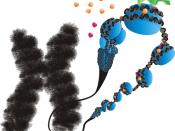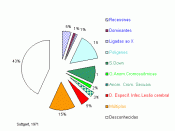CAT EYE SYNDROME
Cat Eye Syndrome (CES) is a rare x-linked mutating disease that occurs on chromosome 22. Cat Eye Syndrome is also referred to as Partial Trisomy, Partial Tetrasomy, or Inverted Duplication. Individuals with a normal chromosomal karyotype have a pair of 22nd chromosomes, both of which have a short arm, known as 22p, and a long arm, called 22q. However, in individuals with cat eye syndrome, the short arm and a small region of the long arm of chromosome 22 are present three or four times rather than twice in cells of the body.
Cat eye syndrome was specifically defined in 1965 when researchers reported cases of individuals with similar symptoms. After tests had been performed it was concluded that the defects occurred on chromosome 22 and the name Cat eye syndrome was given. Most of the features implicated with cat eye syndrome involve the eyes, ears, anal region, heart, and kidneys.
The name "Cat Eye Syndrome" is derived from a distinctive eye abnormality that is present in some affected individuals. This abnormality consists of partial absence of coloboma, or eye tissue. The iris, the middle choroid, and the retina of the eye may all be affected by this absence. Associated abnormalities may vary in severity, but include mild growth delays before birth, mild mental deficiency, and malformations of the skull and facial region. The heart, the kidneys, and/or the anal region may also be influenced. These, and several other abnormalities may occur in more than one family member but are usually only severe in one case while the others may only have mild malformations.
More specifically, individuals with cat eye syndrome frequently have down wards slanting eyelids, widely spaced eyes, crossed eyes, or one eye noticeably smaller than the other. The ears may be misshapen...


